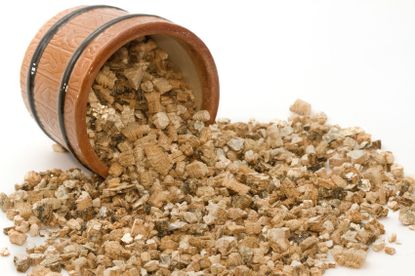What Is Vermiculite: Tips On Using Vermiculite Growing Medium


We all know that plants require soil aeration, nutrition, and water to thrive. If you find that your garden soil is lacking in any or all of these areas, there's something that you can add to improve the soil structure-- vermiculite. What is vermiculite and how is using vermiculite as a growing medium beneficial to the soil?
What is Vermiculite?
Vermiculite is the name of a group of hydrated laminar minerals (aluminum-iron magnesium silicates) which look like mica. Horticultural vermiculite is processed with massive heat that expands it into accordion shaped pellets composed of multiple layers of thin plates. It will not rot, deteriorate, or mold and is enduring, odorless, non-toxic, and sterile. Vermiculite is generally a neutral 7.0 pH, but is dependent upon the source from around the globe and its reaction is alkaline. It is very lightweight and mixes easily with other mediums.
Vermiculite can be found in potting soil or purchased by itself in four different sizes for gardening with vermiculite. Germinate seeds using the smallest size of vermiculite as a growing medium and the largest size for improved soil aeration.
Vermiculite Uses
Vermiculite added to the garden or vermiculite in potting soil increases water and nutrient retention and aerates the soil, resulting in healthier, more robust plants. Perlite may also be found in potting soils, but vermiculite is far superior for water retention. Vermiculite, although less aerating than perlite, is the amendment of choice for water-loving plants. Here are other uses for vermiculite:
- Add vermiculite to soil for conditioning and lightening either alone or in conjunction with peat or compost. This will accelerate the growth and promote anchorage for tender young root systems.
- Using vermiculite as growing medium will also enable the plant to more easily absorb the ammonium, potassium, calcium, and magnesium necessary for vigorous growth.
- Medium grade vermiculite can be used directly for root cuttings. Just water thoroughly and insert the cutting up to the node.
- Use vermiculite alone or mixed with soil or peat for seed germination. This will allow seeds to germinate more rapidly. If vermiculite is used without soil, feed the seedlings a weak fertilizer solution of 1 tablespoon (15 mL.) of soluble fertilizer per 1 gallon (4 L.) of water once the first leaves appear. Damping off is thwarted since vermiculite is sterile and the seedlings are easily removed without damage to the roots.
- Vermiculite mixed half and half with soil, peat, or compost eliminates packed down soil in flower pots and houseplant containers while allowing excellent aeration, reducing watering frequency and allowing root spread.
- To transplant using vermiculite, dig a hole 6 inches (15 cm.) larger than the plants roots. Fill in with a mix of vermiculite and the removed topsoil. Again, this allows for root spread, provides moisture control, and protects the roots from drying out due to sun or wind. 3 inches (8 cm.) of vermiculite can also be used as mulch around shrubs and other garden plants like roses, dahlias, and tomatoes.
- Place bulbs or root crops in a container and pour the vermiculite around them. The sponge-like quality of the vermiculite will absorb any excess moisture and prevent rot or mildew while protecting them from temperature fluxes.
- Even newly seeded lawns can benefit from an application of vermiculite. Mix 3 cubic feet (.08 cubic meter) of vermiculite per 100 square feet (9 square meters), seed, then cover the entire area with ¼ inch (6 mm.) of vermiculite. Water in with a fine spray. The vermiculite will hasten germination and increase the number of seeds that germinate while maintaining moisture and protecting from drying and heat.
- Lastly, vermiculite can be used when arranging flowers. Fill the container with vermiculite, thoroughly saturate with water, pour off the excess, and arrange the flowers. This eliminates the need to change the water, eliminates spills, and keeps blooms fresh for days. Just be sure to use horticultural vermiculite and not that sold for house insulation-- it is treated to repel water!
Gardening tips, videos, info and more delivered right to your inbox!
Sign up for the Gardening Know How newsletter today and receive a free download of our most popular eBook "How to Grow Delicious Tomatoes."

Amy Grant has been gardening for 30 years and writing for 15. A professional chef and caterer, Amy's area of expertise is culinary gardening.